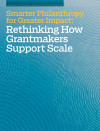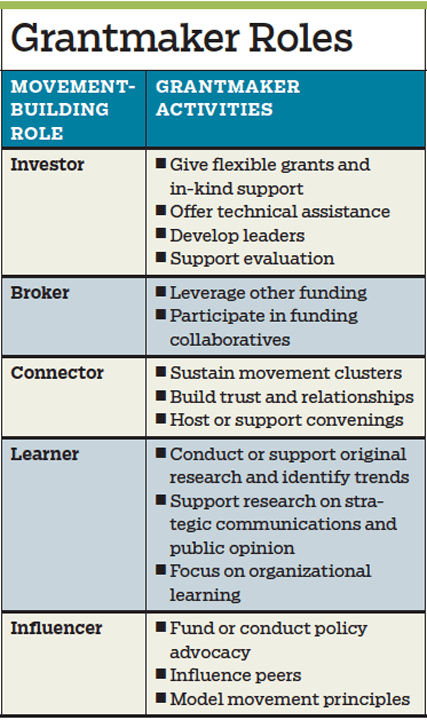SUPPLEMENT TO SSIR SPONSORED BY GRANTMAKERS FOR EFFECTIVE ORGANIZATIONS
Smarter Philanthropy for Greater Impact

This special supplement includes eleven perspectives on “scaling what works”—what it means, what it takes to do it right, and what needs to happen to increase the impact of successful solutions to social challenges.
-
What Would It Take?
-
Emerging Pathways to Transformative Scale
-
Pathways to Scale for a Place-Based Funder
-
The Road to Scale Runs Through Public Systems
-
From Innovation to Results
-
Perspectives on the Social Innovation Fund
-
Partners in Impact
-
We Need More Scale, Not More Innovation
-
More Resources, More Co-Investors, More Impact
-
In Collaboration, Actions Speak Louder than Words
-
Leveraging a Movement Moment
The 50th anniversary of the March on Washington last year served as a reminder of the power and potential of movements for advancing social change. As in the 1960s, when a window of social-change opportunity mobilized people across issues, identities, races, genders, and economic status, today we are in a period of rapid shifts that suggest we are experiencing another “movement moment.”
Many grantmakers recognize this moment as both an opportunity and a challenge. Examples such as international democratic movements and steady progress in lesbian/ gay/bisexual/transgender (LGBT) rights show what can happen when a range of diverse stakeholders rally around a common vision and work together to advance ambitious goals.
But behind the scenes, this work is challenging. It requires dramatic shifts for many grantmakers, both in mindset and in practice.
Philanthropy’s (Many) Roles in Supporting Movements
Grantmakers support movements in diverse and often interconnecting ways, from decades-long general operating grants to public opinion research to community leadership development efforts. Through most of these important activities, grantmakers occupy one of five roles: investor, broker, connector, learner, and influencer.1
Investing money and time. As is the case for strong organizations, movements need support for infrastructure—things like support for leadership that prioritizes intentional relationship building, data and technology systems, and administrative functions. Perhaps more than anything, movements need flexible support in the form of long-term and unrestricted funding.
“In gardening, we are aware that you have to pay attention to the soil, continuously amending and caring for it in order to ensure a plant’s growth,” says Vic DeLuca, president of the Jessie Smith Noyes Foundation. “That same nurturing, feeding, and watering is necessary to facilitate the growth of strong organizations and collaborations.”
In its environmental justice work, the Noyes Foundation recognized that many activist organizations in the southeastern part of the United States were critical to the cause but needed capacity-building support, and fast. In response, the foundation established the Special Assistance Grants program, which allows foundation staff to make grants of up to $7,500 without board approval, sometimes within a few days of a request. Special Assistance Grants have paid for things like technology systems, travel expenses, and board training—all necessary expenses for collaborative work but items rarely covered by program-restricted funding.
Brokering new partnerships. Movement-supporting grantmakers serve as brokers by leveraging other resources for their grantees’ work. An important way grantmakers can do this is through co-funding partnerships. Participating in funding collaboratives not only leverages more money for grantees, it also brings more efficient money, through streamlined application and reporting processes and shared learning among partners.

The Civil Marriage Collaborative is a pooled fund of eight foundations that has awarded more than $17 million to date. The movement is starting to experience some legislative wins—marriage equality was a reality in 17 states as of early 2014—and for the first time ever a majority of Americans support same-sex marriage. A networked approach among grantmakers who support the movement has been critical to these successes.
Serving as connective tissue. Grantmakers with experience in supporting movements say they cannot overemphasize the importance of their role as the “connective tissue” between organizations and networks advancing a movement’s vision. Linda Wood of the Evelyn & Walter Haas, Jr. Fund says, “As foundations, we have a bird’s-eye view of the movement, so we have an obligation to connect the dots with other funders, to support opportunities for funders and activists to work together, and to get money to the work at the right time.”
The Seattle Foundation’s Neighbor to Neighbor Small Grants Program, which awards grants of up to $5,000 to new projects in local communities with economic and racial disparities, connects grantees with like-minded organizations, encourages them to participate in regional initiatives that relate to their issues, and introduces them to other funders so they can advance their collective work.
Advancing learning. Grantmakers can also support movements by helping them advance a deeper understanding of their issues and solutions. This can mean underwriting research, supporting evaluation capacity for networks or organizations, or investing in learning efforts to inform the field’s understanding of movement building and what it will take to create lasting and widespread change.
Grantmakers with experience in supporting movements
emphasize the importance of their role as the “connective
tissue” between organizations and networks.
The Ford Foundation supports a variety of learning activities to advance its work on gender rights and equality. To take the pulse of the community and gain insights for future work, the foundation supports targeted opinion research and other outreach activities. The foundation board carves out time for internal reflection and learning as well, setting aside time in meetings for conversations about timely social issues. For example, in the wake of the recent Supreme Court decisions on marriage rights, the board and staff explored how the foundation’s efforts were supporting this work.
Influencing change. Movements are fundamentally about changing power.2 Funders can use their advocacy capacity and expertise to help advance movement goals. In Arkansas, the Winthrop Rockefeller Foundation brings its learning and research directly to policymakers. Staff members testified before the state legislature, drawing on research the foundation had previously funded, and ultimately influenced the creation of a commission that will study and recommend ways to increase the number of Arkansans with college degrees and remove barriers that impede access to higher education.
But recognizing that the people closest to the problem need to have a voice at the table, funders can also support grantees’ efforts to build advocacy capacity. “If grantees or community leaders are positioned to use their voice, the foundation stands back,” says Regan Gruber Moffitt, senior associate for public policy at the Winthrop Rockefeller Foundation. The foundation also supports grantees’ advocacy efforts.
Three Values for Movement Builders
No matter what role or roles a funder might play in supporting movements, three core values are critical to this work.
First, grantmakers must embrace courage, because supporting social movements requires confronting existing power structures, putting a stake in the ground on issues and values, and taking risks.
Second, grantmakers must embrace trust, because in social movements change starts at the grassroots and involves players at all different levels, each with its own interests, and the process is often messy.
Third, grantmakers must have patience, because this work takes time. Funders who support social movements would agree that working in this way is worth the waiting and uncertainty that can come along with it. As Linda Wood of the Haas, Jr. Fund puts it, “Progress inevitably involves both exhilarating highs and crushing setbacks. As funders, we have to have the fortitude to hang in there, because the end goal of a more just and sustainable society is so important.”
Support SSIR’s coverage of cross-sector solutions to global challenges.
Help us further the reach of innovative ideas. Donate today.
Read more stories by Lori Bartczak.

